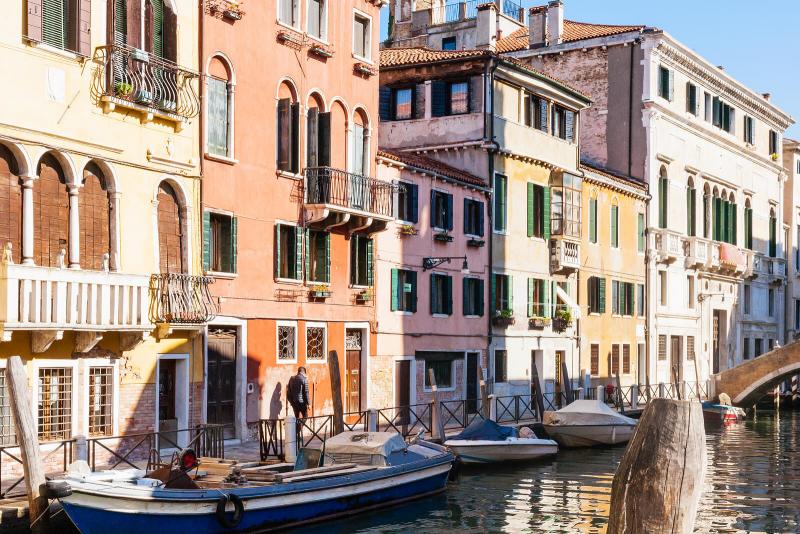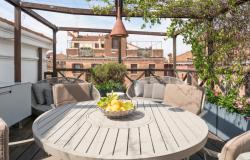Next time you arrive in Venice by train, try something different. Rather than following the masses through the usual itinerary leading to St. Mark’s Square via Ponte degli Scalzi, remain on the side of the Santa Lucia train station and head to Cannaregio, Venice’s second largest sestiere, which extends north of the Grand Canal.
It’s an opportunity to experience Venice without the overwhelming crowds, while taking in magnificent views, discovering artistic and architectural masterpieces, all while walking along quiet calli and campi.
Your first stop is the church everyone ignores, too hurried to reach the Rialto Bridge and St. Mark’s: the Church of Santa Maria di Nazareth, which stands right next to the train station. Its Carrara marble façade is unique in Venice (Istrian stone is what was commonly used in the city), while the interior is a magnificent example of late Venetian Baroque. This is where the last Doge of Venice, Ludovico Manin, who died in 1802, is buried, in the Manin chapel. The church once guarded a fresco by Giambattista Tiepolo, one of the major Venetian painters of the 18th century; the fresco was destroyed during World War I.
Leave the church and proceed toward the heart of Cannaregio, along Strada Nuova to reach Campo San Geremia and the Ponte delle Guglie, the bridge located just before the point where the Cannaregio Canal flows into the Grand Canal; the Cannaregio Canal was the main route into Venice until the construction of the railway connecting to the mainland.
The Ponte delle Guglie leads into the area of the Venetian Ghetto, an area of Cannaregio divided into the Ghetto Nuovo (‘New Ghetto’), and the adjacent Ghetto Vecchio (‘Old Ghetto’), misleading names because the Ghetto Nuovo is actually older than the Ghetto Vecchio.

Beginning in 1516, Jews were restricted to living in the Ghetto. Residents were not allowed to leave from sunset to dawn. The Ghetto was enclosed by guarded gates and connected to the rest of the city by two bridges. Nonetheless, Jews held successful positions in the city: they were merchants, physicians, money lenders.
On the Campo di Ghetto Nuovo are three of the five synagogues founded in the 16th century, and the Museo Ebraico, the museum where you can learn about the long history of Jews in the city. While in the Ghetto, stop by the Panificio Volpe Giovanni for a taste of traditional Kosher pastries.
Walk toward the quiet Campo di Sant’Alvise to find the Church by the same name, dedicated to Saint Louis of Toulouse, built in the 14th century by noblewoman Antonia Venier on the site where, according to tradition, the saint appeared to her in a dream. She retreated into the annexed monastery. The simple Gothic façade contrasts with the rich interior, featuring statues, marbles and altars. Without having to fight for a decent view, you can admire three of Tiepolo masterpieces, Christ Reaching the Calvary, the Coronation of Thorns, and the Flagellation, and a beautiful ‘barco’, the elevated choir used by nuns to attend religious services.
Nearby is another little-known church guarding artworks by another major Venetian painter: Tintoretto (2019 marks 500 years since his birth and there are currently two exhibitions in Venice dedicated to him, at the Doge’s Palace and the Gallerie dell’Accademia). The church is the Madonna dell’Orto, with its façade marking the passage from the Gothic to the Renaissance style. Inside, in the presbytery and in the right nave, there are 10 large canvas by Tintoretto, who lived in Cannaregio and is buried in the church. At an altar to the right of the main entrance is St. John Baptist and Saints by Cima da Conegliano; the Renaissance Valier Chapel once housed a small Madonna with Child by Giovanni Bellini (1481), stolen in 1993. Both were also major Venetian artists, like Tintoretto and Tiepolo, but few venture to see their works in these ‘out-of-the-way’ churches.

As you keep walking in Cannaregio, you’ll pass by Tintoretto’s house, in Fondamenta dei Mori, and proceeding east, by the Scuola Vecchia della Misericordia, which is where the Gallerie dell’Accademia have their restoration laboratories.
Walk until you reach the Chiesa dei Gesuiti, on the campo by the same name, a prime example of Venetian Baroque, whose elegant interiors resemble the rooms of a wealthy palace.
Finally, the last stop on this itinerary of Cannaregio is Ca’D’Oro, ‘golden house’, so called because of the gilt that once adorned its walls. Since 1927, it has been used as a museum, under the name Galleria Giorgio Franchetti, in honor of the baron who bought the palace at the end of the 20th century. The palace itself was built between 1428 and 1430 for the Contarini family, who counted eight Doges among its members between 1043 and 1676. The gallery houses the collection of works of art once belonging to Giorgio Franchetti, and the highlight, which you’re most likely to admire in peace and tranquility, is San Sebastiano by Andrea Mantegna.















